MIR JAFFAR IMAM, the Darbar of Kamadhia and scion of His Highness Nawab Mir Jafur Alee Khan of Surat, is in an exuberant mood. He is treating me to lunch at his palatial residence in Bombay. It is a grand old building called Belha Court on Apollo Bunder from whose balcony I can see the blue hills of Uran and beyond that, the distant horizon on which merchant navy vessels and warships bob on the Arabian Sea. The building is his family�s, and its interiors are like what I imagine those in the four palaces of Surat must be. Full of royal ambience and history! I can smell the food cooking in the kitchen. It is Surti nawabi food. The kind Mir Jaffar Imam�s family has been having since the time the Mughals came to Surat and brought their rich, flavoursome and meaty food with them.
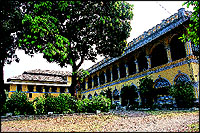 There are actually three branches to the Surat royal family. The Nawab of Belha branch, which is the senior one, and the junior branch of the Nawab of Surat�s family now settled in the UK and the US. The third branch and its members are direct descendants of the male heirs of Nawab Mir Jaffur Alee Khan Bahadur of Surat. He was the son-in-law of the last Nawab of Surat, Mir Afzaluddin, and fought in British Parliament for his succession. His descendants from his son Mir Zulfikar Ali are known as the Darbars of Kamadhia and Scions of the Nawabs of Surat. Mir Jaffar Imam, my princely host, carries this title.
There are actually three branches to the Surat royal family. The Nawab of Belha branch, which is the senior one, and the junior branch of the Nawab of Surat�s family now settled in the UK and the US. The third branch and its members are direct descendants of the male heirs of Nawab Mir Jaffur Alee Khan Bahadur of Surat. He was the son-in-law of the last Nawab of Surat, Mir Afzaluddin, and fought in British Parliament for his succession. His descendants from his son Mir Zulfikar Ali are known as the Darbars of Kamadhia and Scions of the Nawabs of Surat. Mir Jaffar Imam, my princely host, carries this title.
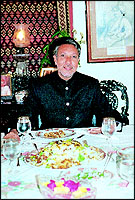 He is a tall and distinguished man, almost leonine in his appearance, and with regal bearing and gourmet habits. There are few people more passionate, and authoritative, about Surti nawabi cuisine than he is. And that is perhaps because the Surat royal family has always been fond of good food. He talks about the �olden days�, when Surti nawabi food was reckoned to be as good as the cuisine popularised by the court of the Nawab of Rampur. I don�t pretend to know anything about this. But I can recognise the aroma of good food when I smell it. And as if to hasten my fast building-up appetite, Mir Jaffar Imam roars to the khansamas in the kitchen to bring
out lunch.
He is a tall and distinguished man, almost leonine in his appearance, and with regal bearing and gourmet habits. There are few people more passionate, and authoritative, about Surti nawabi cuisine than he is. And that is perhaps because the Surat royal family has always been fond of good food. He talks about the �olden days�, when Surti nawabi food was reckoned to be as good as the cuisine popularised by the court of the Nawab of Rampur. I don�t pretend to know anything about this. But I can recognise the aroma of good food when I smell it. And as if to hasten my fast building-up appetite, Mir Jaffar Imam roars to the khansamas in the kitchen to bring
out lunch.
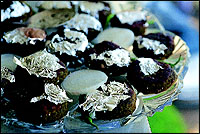 This is not the typically sweet Surti food of Gujarat, vegetarian from first course to last; this is Mughlai food, but unlike that which is cooked in any other Muslim household, royal or common man�s. Mir Jaffar Imam has done me proud for lunch: there is a Mutton Biryani, a Pomfret Chamna, a Masoor Pulao, and Shikampur Kebabs covered with varq. He describes the cuisine to me: �Surti nawabi cuisine is non-vegetarian food that is Mughlai, but which retains the local colloquial touch. It is, however, different from the North Indian Mughlai food.� He is extremely familiar with the cuisine, and can cook it himself, being a great connoisseur of all fine things in life. Occasionally he will go into the kitchen to supervise the khansamas. �If anything is wrong, God help the cook,� says Mir Jaffar Imam with some force.
This is not the typically sweet Surti food of Gujarat, vegetarian from first course to last; this is Mughlai food, but unlike that which is cooked in any other Muslim household, royal or common man�s. Mir Jaffar Imam has done me proud for lunch: there is a Mutton Biryani, a Pomfret Chamna, a Masoor Pulao, and Shikampur Kebabs covered with varq. He describes the cuisine to me: �Surti nawabi cuisine is non-vegetarian food that is Mughlai, but which retains the local colloquial touch. It is, however, different from the North Indian Mughlai food.� He is extremely familiar with the cuisine, and can cook it himself, being a great connoisseur of all fine things in life. Occasionally he will go into the kitchen to supervise the khansamas. �If anything is wrong, God help the cook,� says Mir Jaffar Imam with some force.
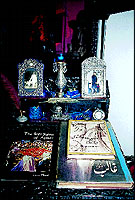 He talks about Surti nawabi food. �The biryanis are not very popular because they can�t be got outside of Surat. They are unique because they are cooked on charcoal, given dum, and one kilo of rice is mixed with two kilos of meat. The yakhni is cooked with the rice. And when serving, it is removed and kept on top of the rice. The Pomfret Chamna is cooked with pudhina and hari mirch. The whole fish is cooked in that. And we also do a Pomfret Biryani. The Shikampur is like a Shammi Kebab, made with lot of curd and without water, and with kishmish. It is fried differently. The Masoor Pulao is a big speciality of the Surat royal family. It is made in the same style as the biryani except in place of the mutton, the masoor is introduced. There is also a very typical dessert, a Muzzafar Shola, which is rice cooked in pineapple juice with badam, pista, charoli, zaffran, kishmish and pineapple pieces in the rice. It is like a North Indian Zarda and cooked on the occasion of marriages in Surat.�
He talks about Surti nawabi food. �The biryanis are not very popular because they can�t be got outside of Surat. They are unique because they are cooked on charcoal, given dum, and one kilo of rice is mixed with two kilos of meat. The yakhni is cooked with the rice. And when serving, it is removed and kept on top of the rice. The Pomfret Chamna is cooked with pudhina and hari mirch. The whole fish is cooked in that. And we also do a Pomfret Biryani. The Shikampur is like a Shammi Kebab, made with lot of curd and without water, and with kishmish. It is fried differently. The Masoor Pulao is a big speciality of the Surat royal family. It is made in the same style as the biryani except in place of the mutton, the masoor is introduced. There is also a very typical dessert, a Muzzafar Shola, which is rice cooked in pineapple juice with badam, pista, charoli, zaffran, kishmish and pineapple pieces in the rice. It is like a North Indian Zarda and cooked on the occasion of marriages in Surat.�
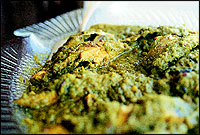 And Nawab Mir Jaffar Imam talks of himself. His book, Mirza Ghalib And The Mirs of Gujarat, describes him as a social scientist specialising in human relations and industrial communications. His wife, Anees Begum, is from a Hyderabadi zamindar family, and her influence in his life is the vast and rich Hyderabadi cuisine of which he is equally fond. They have one son, Kumarshree Nawabzada Moin Mir, who is London educated and who has married Farah Begum, the
grand-niece of King Zahir Shah of Afghanistan. �I am happy to be part of the modern world but retain roots in my 500-year-old royalty,� he says. �I keep the etiquette, clothes, charm and food
of old in this modern world. Especially the food.�
And Nawab Mir Jaffar Imam talks of himself. His book, Mirza Ghalib And The Mirs of Gujarat, describes him as a social scientist specialising in human relations and industrial communications. His wife, Anees Begum, is from a Hyderabadi zamindar family, and her influence in his life is the vast and rich Hyderabadi cuisine of which he is equally fond. They have one son, Kumarshree Nawabzada Moin Mir, who is London educated and who has married Farah Begum, the
grand-niece of King Zahir Shah of Afghanistan. �I am happy to be part of the modern world but retain roots in my 500-year-old royalty,� he says. �I keep the etiquette, clothes, charm and food
of old in this modern world. Especially the food.�





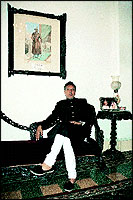 The Surti Nawabi Cuisine Of Mir Jaffar Imam!
The Surti Nawabi Cuisine Of Mir Jaffar Imam!
 There are actually three branches to the Surat royal family. The Nawab of Belha branch, which is the senior one, and the junior branch of the Nawab of Surat�s family now settled in the UK and the US. The third branch and its members are direct descendants of the male heirs of Nawab Mir Jaffur Alee Khan Bahadur of Surat. He was the son-in-law of the last Nawab of Surat, Mir Afzaluddin, and fought in British Parliament for his succession. His descendants from his son Mir Zulfikar Ali are known as the Darbars of Kamadhia and Scions of the Nawabs of Surat. Mir Jaffar Imam, my princely host, carries this title.
There are actually three branches to the Surat royal family. The Nawab of Belha branch, which is the senior one, and the junior branch of the Nawab of Surat�s family now settled in the UK and the US. The third branch and its members are direct descendants of the male heirs of Nawab Mir Jaffur Alee Khan Bahadur of Surat. He was the son-in-law of the last Nawab of Surat, Mir Afzaluddin, and fought in British Parliament for his succession. His descendants from his son Mir Zulfikar Ali are known as the Darbars of Kamadhia and Scions of the Nawabs of Surat. Mir Jaffar Imam, my princely host, carries this title. He is a tall and distinguished man, almost leonine in his appearance, and with regal bearing and gourmet habits. There are few people more passionate, and authoritative, about Surti nawabi cuisine than he is. And that is perhaps because the Surat royal family has always been fond of good food. He talks about the �olden days�, when Surti nawabi food was reckoned to be as good as the cuisine popularised by the court of the Nawab of Rampur. I don�t pretend to know anything about this. But I can recognise the aroma of good food when I smell it. And as if to hasten my fast building-up appetite, Mir Jaffar Imam roars to the khansamas in the kitchen to bring
out lunch.
He is a tall and distinguished man, almost leonine in his appearance, and with regal bearing and gourmet habits. There are few people more passionate, and authoritative, about Surti nawabi cuisine than he is. And that is perhaps because the Surat royal family has always been fond of good food. He talks about the �olden days�, when Surti nawabi food was reckoned to be as good as the cuisine popularised by the court of the Nawab of Rampur. I don�t pretend to know anything about this. But I can recognise the aroma of good food when I smell it. And as if to hasten my fast building-up appetite, Mir Jaffar Imam roars to the khansamas in the kitchen to bring
out lunch. This is not the typically sweet Surti food of Gujarat, vegetarian from first course to last; this is Mughlai food, but unlike that which is cooked in any other Muslim household, royal or common man�s. Mir Jaffar Imam has done me proud for lunch: there is a Mutton Biryani, a Pomfret Chamna, a Masoor Pulao, and Shikampur Kebabs covered with varq. He describes the cuisine to me: �Surti nawabi cuisine is non-vegetarian food that is Mughlai, but which retains the local colloquial touch. It is, however, different from the North Indian Mughlai food.� He is extremely familiar with the cuisine, and can cook it himself, being a great connoisseur of all fine things in life. Occasionally he will go into the kitchen to supervise the khansamas. �If anything is wrong, God help the cook,� says Mir Jaffar Imam with some force.
This is not the typically sweet Surti food of Gujarat, vegetarian from first course to last; this is Mughlai food, but unlike that which is cooked in any other Muslim household, royal or common man�s. Mir Jaffar Imam has done me proud for lunch: there is a Mutton Biryani, a Pomfret Chamna, a Masoor Pulao, and Shikampur Kebabs covered with varq. He describes the cuisine to me: �Surti nawabi cuisine is non-vegetarian food that is Mughlai, but which retains the local colloquial touch. It is, however, different from the North Indian Mughlai food.� He is extremely familiar with the cuisine, and can cook it himself, being a great connoisseur of all fine things in life. Occasionally he will go into the kitchen to supervise the khansamas. �If anything is wrong, God help the cook,� says Mir Jaffar Imam with some force. He talks about Surti nawabi food. �The biryanis are not very popular because they can�t be got outside of Surat. They are unique because they are cooked on charcoal, given dum, and one kilo of rice is mixed with two kilos of meat. The yakhni is cooked with the rice. And when serving, it is removed and kept on top of the rice. The Pomfret Chamna is cooked with pudhina and hari mirch. The whole fish is cooked in that. And we also do a Pomfret Biryani. The Shikampur is like a Shammi Kebab, made with lot of curd and without water, and with kishmish. It is fried differently. The Masoor Pulao is a big speciality of the Surat royal family. It is made in the same style as the biryani except in place of the mutton, the masoor is introduced. There is also a very typical dessert, a Muzzafar Shola, which is rice cooked in pineapple juice with badam, pista, charoli, zaffran, kishmish and pineapple pieces in the rice. It is like a North Indian Zarda and cooked on the occasion of marriages in Surat.�
He talks about Surti nawabi food. �The biryanis are not very popular because they can�t be got outside of Surat. They are unique because they are cooked on charcoal, given dum, and one kilo of rice is mixed with two kilos of meat. The yakhni is cooked with the rice. And when serving, it is removed and kept on top of the rice. The Pomfret Chamna is cooked with pudhina and hari mirch. The whole fish is cooked in that. And we also do a Pomfret Biryani. The Shikampur is like a Shammi Kebab, made with lot of curd and without water, and with kishmish. It is fried differently. The Masoor Pulao is a big speciality of the Surat royal family. It is made in the same style as the biryani except in place of the mutton, the masoor is introduced. There is also a very typical dessert, a Muzzafar Shola, which is rice cooked in pineapple juice with badam, pista, charoli, zaffran, kishmish and pineapple pieces in the rice. It is like a North Indian Zarda and cooked on the occasion of marriages in Surat.� And Nawab Mir Jaffar Imam talks of himself. His book, Mirza Ghalib And The Mirs of Gujarat, describes him as a social scientist specialising in human relations and industrial communications. His wife, Anees Begum, is from a Hyderabadi zamindar family, and her influence in his life is the vast and rich Hyderabadi cuisine of which he is equally fond. They have one son, Kumarshree Nawabzada Moin Mir, who is London educated and who has married Farah Begum, the
grand-niece of King Zahir Shah of Afghanistan. �I am happy to be part of the modern world but retain roots in my 500-year-old royalty,� he says. �I keep the etiquette, clothes, charm and food
of old in this modern world. Especially the food.�
And Nawab Mir Jaffar Imam talks of himself. His book, Mirza Ghalib And The Mirs of Gujarat, describes him as a social scientist specialising in human relations and industrial communications. His wife, Anees Begum, is from a Hyderabadi zamindar family, and her influence in his life is the vast and rich Hyderabadi cuisine of which he is equally fond. They have one son, Kumarshree Nawabzada Moin Mir, who is London educated and who has married Farah Begum, the
grand-niece of King Zahir Shah of Afghanistan. �I am happy to be part of the modern world but retain roots in my 500-year-old royalty,� he says. �I keep the etiquette, clothes, charm and food
of old in this modern world. Especially the food.�